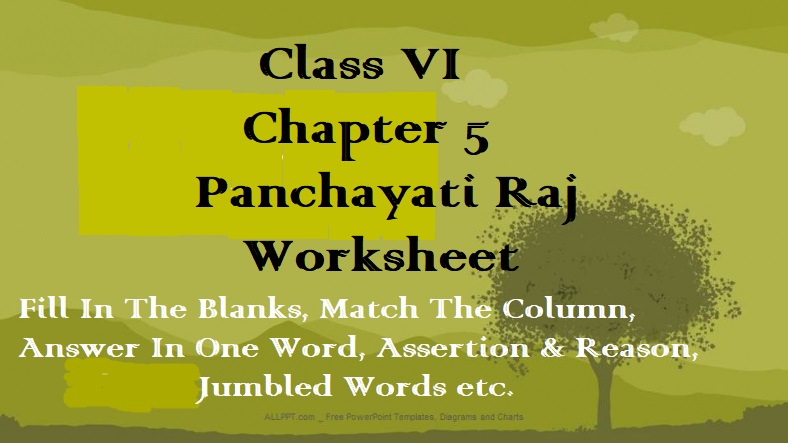Panchayati Raj Worksheet With Various Types Of Questions
Panchayati Raj Worksheet is designed for class VI students to test your understanding and knowledge. Welcome to the world of Panchayati Raj, a fundamental aspect of rural governance in India. This Panchayati Raj worksheet, is going to test you through a diverse range of question types.
In this worksheet, you will encounter fill-in-the-blanks questions to assess your grasp of key terms and concepts. Answer-in-one-word questions will challenge your ability to provide concise responses. Match the following questions will test your ability to pair related ideas. Assertion and reason questions will encourage critical thinking and analytical skills. Jumbled words will evaluate your vocabulary and spelling abilities. Lastly, you’ll have the opportunity to correct statements to deepen your comprehension of Panchayati Raj.
So, get ready to embark on this engaging journey into the world of rural governance in India, and let’s begin exploring Panchayati Raj together!
Panchayati Raj Worksheet With Various Types Of Questions
Fill In The Blanks: assess your grasp of key terms and concepts
Here are 10 fill-in-the-blanks questions from a Class VI Civics Chapter 5 on Panchayati Raj, along with their answers.
Use these questions and answers to enhance your understanding of the Panchayati Raj system in India.
- Panchayati Raj is a system of ____________ at the local level in India.
- The Panchayati Raj system was introduced in India through the _________ Amendment Act.
- The three-tier structure of Panchayati Raj consists of Gram Panchayat, ____________, and Zilla Parishad.
- The head of a Gram Panchayat is known as the _________
- The members of the Gram Panchayat are elected by the ____________.
- Panchayati Raj institutions are responsible for ____________ development.
- The Panchayat Samiti is also known as the ____________ level of Panchayati Raj.
- The Panchayat Samiti coordinates the work of Gram Panchayats within a ____________.
- The highest tier of Panchayati Raj is the ____________.
- The Zilla Parishad is responsible for planning and implementation of ____________ development schemes.
ANSWERS:
- Local self-government 2. 73rd 3. Panchayat Samiti 4. Sarpanch 5. People in the village 6. Local 7. Intermediate 8. Block 9. Zilla Parishad 10. District
“Answer in One Word” questions: challenge your ability to provide concise responses
Here are 10 “Answer in One Word” questions from a Class VI Civics Chapter 5 on Panchayati Raj, along with their answers.
These questions will help reinforce your knowledge of the Panchayati Raj system in India.
- What is the term for the elected head of a Gram Panchayat?
- Who is responsible for coordinating the work of multiple Gra m Panchayats within a block?
- What is the highest tier of the Panchayati Raj system?
- What is the process of electing members of a Gram Panchayat called?
- What type of development do Panchayati Raj institutions primarily focus on?
- What is the primary role of a Zilla Parishad?
- Which constitutional amendment introduced the Panchayati Raj system in India?
- What is the intermediate level of Panchayati Raj known as?
- What do you call the local self-government system in India?
- Who elects the members of Gram Panchayats?
ANSWERS:
- Sarpanch 2. Panchayat Samiti 3. Zilla Parishad 4. Elections 5. Local 6. Planning and implementation 7. 73rd 8. Panchayat Samit 9. Panchayati Raj 10. People in the village
Panchayati Raj Worksheet With Various Types Of Questions
Match The Following: Test your ability to pair related ideas
| A | B |
| SARPANCH | Highest tier of Panchayati Raj |
| ZILA PARISHAD | Responsible for district-level planning and implementation |
| PANCHAYAT SAMITI | Process of choosing representatives |
| INTERMEDIATE LEVEL | Head of a Gram Panchayat |
| ELECTIONS | Coordinates the work of multiple Gram Panchayats within a block |
Match The Following: Test your ability to pair related ideas
| A | B |
| Local Governance | Responsible for the overall development of a district |
| Zilla Parishad | Decision-making and administration at the grassroots level |
| Gram Sabha | plays a significant role in making decisions at the Gram Panchayat level |
| Village Assembly | Responsible for coordinating development activities in a block |
| Panchayat Samiti | Assembly of all adult members in a village |
Assertion & Reason Based Questions: Enhance critical thinking and analytical skills
Instructions: For each question, evaluate whether the provided Assertion (A) and Reason (R) are true or false and then choose the appropriate option accordingly. Evaluate each pair of Assertion and Reason statements and select the appropriate option for each question.
- Assertion (A): Gram Panchayats are responsible for district-level planning. Reason (R): Zilla Parishads are the highest tier in the Panchayati Raj system.
- A. Both A and R are true, and R is the correct explanation of A.
- B. Both A and R are true, but R is not the correct explanation of A.
- C. A is true, but R is false.
- D. Both A and R are false.
- Assertion (A): Panchayati Raj institutions focus on local development. Reason (R): They have the authority to make national-level policies.
- A. Both A and R are true, and R is the correct explanation of A.
- B. Both A and R are true, but R is not the correct explanation of A.
- C. A is true, but R is false.
- D. Both A and R are false.
- Assertion (A): The Panchayat Samiti coordinates the work of Gram Panchayats within a block. Reason (R): Gram Panchayats have no interaction with each other.
- A. Both A and R are true, and R is the correct explanation of A.
- B. Both A and R are true, but R is not the correct explanation of A.
- C. A is true, but R is false.
- D. Both A and R are false.
- Assertion (A): The 73rd Amendment Act introduced the Panchayati Raj system in India. Reason (R): The government wanted to decentralize power and promote local self-governance.
- A. Both A and R are true, and R is the correct explanation of A.
- B. Both A and R are true, but R is not the correct explanation of A.
- C. A is true, but R is false.
- D. Both A and R are false.
Assertion & Reason Based Questions: Enhance critical thinking and analytical skills
- Assertion (A): The Gram Sabha is an assembly of all adults in a village. Reason (R): The Gram Sabha has no role in decision-making at the village level.
- A. Both A and R are true, and R is the correct explanation of A.
- B. Both A and R are true, but R is not the correct explanation of A.
- C. A is true, but R is false.
- D. Both A and R are false.
2. Assertion (A): The Panchayati Raj system was introduced in India to centralize power in the hands of the national government. Reason (R): It aimed to bring decision-making closer to the people at the grassroots level.
- A. Both A and R are true, and R is the correct explanation of A.
- B. Both A and R are true, but R is not the correct explanation of A.
- C. A is true, but R is false.
- D. Both A and R are false.
- Assertion (A): The head of a Gram Panchayat is known as the Sarpanch. Reason (R): Sarpanch is the elected representative of the Zilla Parishad.
- A. Both A and R are true, and R is the correct explanation of A.
- B. Both A and R are true, but R is not the correct explanation of A.
- C. A is true, but R is false.
- D. Both A and R are false.
Assertion & Reason Based Questions: Enhance critical thinking and analytical skills
- Assertion (A): Panchayati Raj institutions are responsible for coordinating development activities at the state level. Reason (R): They have no role in state-level governance.
- A. Both A and R are true, and R is the correct explanation of A.
- B. Both A and R are true, but R is not the correct explanation of A.
- C. A is true, but R is false.
- D. Both A and R are false.
- Assertion (A): Gram Panchayats are responsible for local-level planning and implementation. Reason (R): Zilla Parishads focus only on national-level development schemes.
- A. Both A and R are true, and R is the correct explanation of A.
- B. Both A and R are true, but R is not the correct explanation of A.
- C. A is true, but R is false.
- D. Both A and R are false.
- Assertion (A): Panchayati Raj institutions aim to promote decentralization of power. Reason (R): Decentralization means shifting power from the central government to local bodies.
- A. Both A and R are true, and R is the correct explanation of A.
- B. Both A and R are true, but R is not the correct explanation of A.
- C. A is true, but R is false.
- D. Both A and R are false.
Panchayati Raj Worksheet With Various Types Of Questions
Jumbled words – Evaluate your vocabulary and spelling abilities
- RAMG AHBSA
- LIAZ ARPDSIHA
- PSARNCHA
- EVIALGL AMITIS
- IESLNECOT
- IPATNCAHYA JAR
- EGALLIV YLB MESSA
- OCALL GMOVEERNNT
- TAAYPANCH SEOLIETCN
- OLCAL EFLS GOVMENTERN
ANSWERS:
- GRAM SABHA
- ZILA PARISHAD
- SARPANCH
- VILLAGE SAMITI
- ELECTIONS
- PANCHAYATI RAJ
- VILLAGE ASSEMBLY
- LOCAL GOVERNMENT
- PANCHAYAT ELECTION
- LOCAL SELF GOVERNMENT
Conclusion On Panchayati Raj Worksheet
Panchayati Raj worksheet for Class VI offers a thorough overview of the system of local government in India. The worksheet helps to reinforce the important ideas covered in the chapter by including a variety of question types, including fill-in-the-blank, match-the-column, one-word answers, assertion and reason-based, and jumbled words. Through this Panchayati Raj worksheet, students are pushed to recollect information, draw connections between ideas, and engage in critical thought regarding the design and operation of Panchayati Raj institutions through the use of these varied question types. Their knowledge is increased, and it also fosters critical thinking and problem-solving abilities. With the help of this worksheet, students can better understand the role that local self-government plays in our democratic system, laying a solid foundation for their civic education.
For the Lesson Plan on Panchayati Raj, click on the given link.





0 Comments